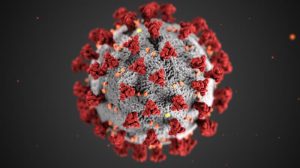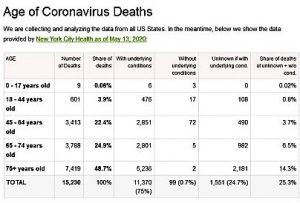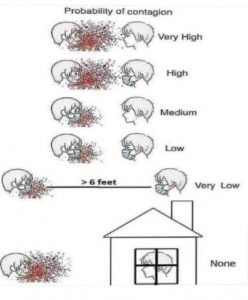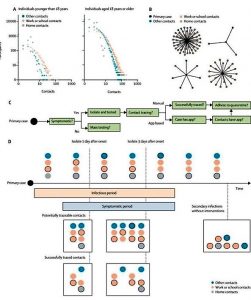Having crossed the initial hurdle of accepting the present COVID-19 pandemic context and uncertainties that the future entails, we are now faced with answering how this ‘new normal’ should pan out across different sectors. As some human activities will become redundant, others will have to rapidly adapt. In essence, we are fast approaching the age where not just the ‘fittest’ will survive, but also those who are ‘quickest’ to adapt to this new way of life
Credit: Centers for Disease Control and Prevention (CDC)
By
Dr. Subhash Hira, Professor of Global Health, University of Washington-Seattle
Sudhanshu Malhotra, Sambodhi Research and Communications, New Delhi, India
Santosh Gupta, Indian Social Responsibility Network, New Delhi, India
Kaamila Patherya, Sambodhi Research and Communications, New Delhi, India
Addresses for correspondence: hiras2@uw.edu; kaamila.patherya@sambodhi.co.in
How to Survive COVID-19: Now and the Future
It is now globally acknowledged that the COVID-19 pandemic has changed our world for good. People across the globe are navigating on a daily basis what the ‘new normal’ will look like. The initial denial, confusion and resentment has given way to gradual acceptance that the coronavirus is here to stay and it is up to communities to find ways of living with it by minimizing risk to the greatest extent, both in terms of health as well as social and economic life.
Having crossed the initial hurdle of accepting the present context and uncertainties that the future entails, we are now faced with answering how this ‘new normal’ should pan out across different sectors. As some human activities will become redundant, others will have to rapidly adapt. In essence, we are fast approaching the age where not just the ‘fittest’ will survive, but also those who are ‘quickest’ to adapt to this new way of life.
Social and Economic Restructuring
Epidemiologic Status of COVID-19 as of June 18, 2020
Figure 1: Slides 1-4 show global cases, deaths, sex and age distribution of deaths. Slides 5-6 depict Indian figures by mid-June 2020
Source: Worldometer, JHU https://www.worldometers.info/coronavirus/?utm_campaign=homeAdvegas1?%22%20%5Cl%20%22countri#countries
Wuhan, China being the epicenter, COVID-19 has developed into a pandemic with small chains of transmission in many countries and large chains resulting in extensive spread in a several countries, such as Italy, Iran, South Korea, USA, and Japan. While the number of cases in India is on the increase, we know that as epidemics progress the effective reproduction number (R0) declines until it falls below unity in value when the epidemic peaks and then decays, either due to the exhaustion of people susceptible to infection and/or the impact of control measures. With the governments gradually lifting lockdown measures, reducing transmission will primarily be an individual-level effort involving social distancing, mask-wearing, hand hygiene, and self-isolation. [1,2]
Social and Mental Health Impacts of COVID-19
Countries across the globe are facing major social transformations that dictate their behaviors and interactions. These impacts are particularly staggering for Global South countries where marginalized populations are facing serious setbacks along vital SDG parameters such as gender equality, education, employment, refugees, and environmental protection. Historically, there has been a strong correlation between epidemics and increase in human trafficking. COVID-19 could offset gross human rights violations on women, refugees, and children, and could also disadvantage the elderly. Scaling in counseling services for lonely patients and families with COVID and accelerating community participation must be made a priority.
Equally important is the need to focus on mental health. Healthcare workers, those already dealing with mental health pre-COVID, and people with disabilities as those who are at greatest mental health risk during this period. It is important to destigmatize groups such as elderly people and healthcare workers, and to stress on the importance of basic care such as eating and sleeping. Helplines and deploying mental health professionals will be paramount in helping people deal with anxiety, resentment, depression, and trauma induced by lockdowns. Setting routines, meditation, expression of gratitude, and adaptability are useful practices in helping individuals cope with the volatile period.
Economic Impact
Figure 2: Mapping select countries based on comparative lockdown restrictions and socio-economic outcomes. Source: Boston Consulting Group (with modifications)
Figure 2 above shows various levels of lockdown restrictions in different countries represented by blue, pink, or red halos. Quadrant 1 where Vietnam and other countries show blue halo, meaning low restrictions. In Quadrant 2, India is seen with blue halo i.e. low restrictions, South Africa with pink halo i.e. moderate restrictions, and Argentina with red halo i.e. severe lockdown restrictions.
The quadrants are made up by vertical axis representing economic outcomes using GDP and industrial/agricultural production indicators, and horizontal axis shows Public Health (PH) outcomes using number of COVID cases detected, fatality rate, and social outcomes.
Quadrant 1 is characterized by high economic and high Public Health outcomes. The countries include China, Vietnam, Bangladesh, Indonesia, where low to moderate lockdown restrictions were used. Quadrant 2 shows low economic but high PH outcomes, including India, South Africa, Germany, Australia, South Korea, Taiwan, Japan. Low to high lockdown restrictions were used. Quadrant 3 displays low economic and low PH outcomes, including economies such as the USA, UK, Brazil, Saudi Arabia, Iran.. Moderate to high lockdown restrictions were instituted in these countries. Quadrant 4 has high economic but worse PH outcomes, including majorly of EU countries. Here, there were moderate restrictions, pictured with the pink halo.
It can be inferred that Quadrant 1 countries got the best socio-economic outcomes, and Quadrant 3 countries got the worst socio-economic outcomes.
Figure 3: IMF World Economic Outlook
Figure 3 above provided by the IMF in April 2020 shows real GDP of major countries and how this has comparatively changed over 2019 and 2020 due to the impacts of COVID-19.The real GDP of the United States will fall to 1/4th of what it was the last year.EU countries will collectively lose their GDP to 1/7th of what it was. Japan GDP will drop to 1/8th of what it was the last year. The Indian GDP will drop from 4.2 to 1.9, which is almost like one half. On a comparative scale, Indian GDP still survives with significantly lesser drop than countries such as South Africa or Brazil or even China to that extent.
Based on these trends across countries that are at various stages of lockdown, it seems that the economic slump will be varied and different from recessions in the past. Unlike past recessions, the economy should recover more swiftly, and the scenario should start inching towards business-as-normal within the next 6-8 months. Adopting a protectionist stance will have to be viewed with some caution, as developed economies imposing high tariffs could negatively impact some of the emerging economies. Economic reforms accompanying the rollout of stimulus packages, similar to the approach adopted by India, might be a useful mechanism to put countries back on the path of speedy economic recovery.
With the above major changes happening in the world, the following five concepts define the ‘new normal’ areas for our survival: Acceptance that the world has changed forever with onset of COVID-19 pandemic. Adaptation is required in all spheres of human life. It will be survival of the “quickest”; not survival of the ‘fittest’. Accept “forced entrepreneurship” as the way to survive in the industry of your choice. In order to avoid making mistakes, drop your ‘ego’ and accept changes as they come.
Sectoral Changes
Personal Protection
While governments are actively taking steps for prevention and containment, protection is primarily the individual’s responsibility. Mask wearing, frequent hand washing, and maintaining 6 feet physical distance are becoming ingrained in our social behaviors. [3] Mask wearing, in fact, has long been a tradition in many countries such as Japan as a precautionary step against respiratory diseases. Other countries would do well to similarly adopt these measures as a way of life. According to research studies, the cotton mask is as effective as a medical mask for protection. [3,4] In developing countries including India, owing to socio-economic disparity, homemade masks or cloth coverings that protect the nose and mouth are sufficient and practical solutions. Figure 5 shows findings of a mathematical modeling study, wherein there is an average of 30-50 contacts/day for individuals <18 years of age, and an average of 100 contacts/day for individuals >=18 years of age. [4]
Figure 4: Probability of contagion at various levels of protection
Figure 5: Effectiveness of various protection measures in reducing transmission [4]
Travel, Hospitality Industry, and Vacations
The delayed closing of international flights and borders was not only the primary cause for global transmission of the virus that deemed it a pandemic, but it is also the most alarming aspect that sets it apart from other epidemics of the past. In the case of SARS in Hong Kong or Ebola in Africa, shutting down flights and closing borders was the first governmental response measure to contain the spread of infections. Needless to say, the lack of these measures for COVID-19 is what has transpired into the current state of affairs.
As borders gradually open and certain flight routes resume, we will have to continue to approach travel with some caution till some time to come. Tourism and non-essential travel must be stalled. While airlines are enforcing strong protection measures, air travel should only be resorted to when absolutely essential.
The Future of Work from Home
We are transitioning not just in terms of how we work, but also in the very nature of work itself. Occupations which demand close contact, such as in restaurants, hospitality, malls, salons etc., are the most impacted. However, the economy is fast adapting to a new way of doing business. The ‘digital economy’ has been infused with new vigor, and one can foresee emerging demand for a host of new services. Online teaching, for example, is emerging. The work from home model is now largely accepted as the way of the future. [2]
Apart from digital businesses, the health sector and alternative medicine will both see a surge. Investments in this space will also increase. Startups focusing on how technology and Data Science can optimize public health are also appearing on the horizon.
Entertainment and Leisure
The old ways for entertainment and leisure will probably not resume for some time to come. Cinema halls, malls, and restaurants, though gradually opening up, continue to pose some risk. However, this need not necessarily result in the stalling of entertainment activities. Home-based streaming services are providing access to films and media at nominal costs, and video conferencing software are ensuring that people are connected for meetings and consultations. Adapting to new mode of enjoyment, as opposed to its altogether disbandment, is how we need to reorient our thinking.
Education
While the economy may have momentarily halted in the last few months, learning and education across the globe has remained largely unaffected at least in private and university settings. The mode of instruction has moved to the virtual space, and it will be so for some time to come. The challenge will now be to navigate how public schools and establishments in remote areas and villages that lack access to technology can be resumed. Testing at end-of-course is another concern that institutions across the world are currently finding solutions to. Virtual teaching, which had been gathering momentum, is now going to be indispensable. The benefits offered in terms of access, reach, and innovative methods are fast convincing education professionals as well as students of the efficacy of this medium of instruction.
Treatments, Vaccines and Herd Immunity
A variety of approved treatments are being used by the Government of India to treat COVID-19 patients. Hydroxychloroquine (HCQ), Azithromycin, Oseltamivir, Vitamin C tablets, among other drugs, are being administered depending on specific patient conditions. Convalescent plasma therapy, which has successfully treated other infectious diseases in the past, is being used for severe COVID-19 cases and the initial results have been favorable. [5,6,7]
There has been some debate on the usage of Hydroxychloroquine (HCQ) in the treatment of COVID-19. Despite claims, there is no conclusive evidence against is usage as yet and in-vitro studies have shown that HCQ reduces viral shedding and also hampers replication. The only concern is that of cardiotoxicity and ECG baselines have to be done to determine usage. [8]
While we continue to remain hopeful for a vaccine for COVID, we must learn and be cognizant of realities and of our experiences with vaccines throughout the course of history. The Smallpox vaccine took almost 200 years to develop and the Polio vaccine took almost 60 years. Several rounds of animal and human level testing are involved in developing vaccines and taking shortcuts in this regard can be dangerous. We need to wait at least 18 months before we reach any conclusions regarding a potential COVID vaccine. Even after discovery, administering it to a global population will not be an easy task. Instead of pinning hopes on the vaccine, it is important to reorient our thinking to how we can adapt and live with coronavirus. Wishful thinking of vaccine as a magic bullet could be misleading at this stage.
The theme of herd immunity is also being deliberated. Sweden, after a couple of weeks of lockdown, has adopted a stance of minimal restrictions and eventual herd immunity as a means of responding to the pandemic. However, this is still widely contested with inconclusive evidence, particularly since the parameter to judge the herd immunity raises challenges. [7] Normally, it is known that once the body fights a disease, antibodies are produced in the bloodstream which protect against future infections. However, antibodies can be created in the body for various reasons, rendering it not the best parameter to judge herd immunity. In some animal models, it may take 6-8 months for herd immunity to develop. Neutralizing antibodies take very long to develop, and more research is needed in this space. [9]
Alternative Medicine
While we continue to protect ourselves from COVID through safety measures, strengthening our innate mechanisms to fight infections is an equally important aspect that deserves attention. Alternative medicine, in particular Ayurveda and homeopathy, hold some potential in this regard. As a prophylactic measure, homeopathic treatments have been known to boost immunity and the body’s natural defenses against infections. In fact, homeopathic treatments have been widely used during past epidemics such as cholera, Spanish flu etc. While they may not be able to scientifically prevent infection, they do not pose any harm or side-effects. [10]
Conclusion
The COVID-19 pandemic has transformed the social and economic fabric of our lives. While on the one hand the effects have been catastrophic in terms of lives and livelihoods lost, the speed and optimism with which communities and businesses have responded holds testament to the innate adaptability of human beings as a species. Adapting, the very quality that ensures our survival on earth, will prove most instrumental in how we meet the challenges and demands of ‘new normal’ in the future.
References
- Roy M Anderson, Hans Heesterbeek, Don Klinkenberg, Déirdre Hollingsworth. How will country-based mitigation measures influence the course of the COVID-19 epidemic? https://doi.org/10.1016/S0140-6736(20)30567-5
- Mark Barnes, Paul E. Sax. Challenges of “Return to Work” in an Ongoing Pandemic. The New England Journal of Medicine. https://www.nejm.org/doi/full/10.1056/NEJMsr2019953
- Derek K Chu, Elie A Akl, Stephanie Duda, Karla Solo, Sally Yaacoub, Holger J Schünemann, on behalf of the COVID-19 Systematic Urgent Review Group Effort (SURGE) study authors. Physical distancing, face masks, and eye protection to prevent person-to-person transmission of SARS-CoV-2 and COVID-19: a systematic review and meta-analysis. https://www.thelancet.com/journals/lancet/article/PIIS0140-6736(20)31142-9/fulltext
- Stadnytskyi V, Bax CE, Bax A, Anfinrud P. The airborne lifetime of small speech droplets and their potential importance in SARS-CoV-2 transmission. Proc Natl Acad Sci U S A. 2020;117(22):11875‐11877. doi:10.1073/pnas.2006874117
- Government of India, Ministry of Health and Family Welfare, Directorate General of Health Services (EMR Division). Clinical Management Protocol: COVID-19. https://www.mohfw.gov.in/pdf/ClinicalManagementProtocolforCOVID19.pdf
- World Health Organization. Clinical management of COVID-19: Interim guidance, May 2020.
- World Health Organization. Key criteria for the ethical acceptability of COVID-19 human challenge studies. Reference number: WHO/2019-nCoV/Ethicscriteria/2020.1
- Anwar M. Hashem,Badrah S. Alghamdi,Abdullah A. AlgaissiFahad S. Alshehri, Abdullah Bukhari, Mohamed A. Alfaleh, and Ziad A. Memish. Therapeutic use of chloroquine and hydroxychloroquine in COVID-19 and other viral infections: A narrative review. https://doi.org/10.1016/j.tmaid.2020.101735
- Haley E. Randolph, Luis B. Barreiro. Herd Immunity: Understanding COVID:19. https://doi.org/10.1016/j.immuni.2020.04.012
- Government of India, Ministry of AYUSH. GUIDELINES for HOMOEOPATHIC PRACTITIONERS for COVID 19. https://www.ayush.gov.in/docs/homeopathy-guidelines.pdf










